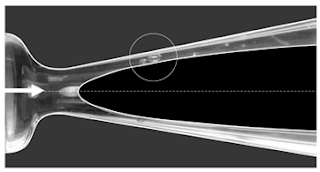The concept of Hydrodynamic Cavitation
|
|
|
|
At low
flowrate, water is everywhere free of cavitation. Velocity is maximum in the
section of minimum area and pressure is then minimum.
When the
flow rate is progressively increased, the minimum pressure decreases and
there will be a critical flowrate for which the vapour pressure is obtained
at the throat.
At this
operating point, cavitation appears in the section of minimum area. In Figure,
two bubbles are clearly visible in the upper part of the Venturi. This is the
start of the cavitation state.
|
If the flow
rate through the Venturi is further increased, the extent of cavitation
increases.
At this
point the chlorine when injected will oxidise the organic matter in exploded
bubble and due to the large surface area available, the oxidation by chlorine
molecule is almost instantaneous.
|
ü
There is no limitation on the levels of TDS
concentration. Generally Biological systems cannot accept TDS concentration
> 8000 mg/L
ü
Any concentration of Ammoniacal nitrogen and phenolic
compounds can be treated.
ü
It has got a very small foot print. GIDC handed over
the plant of 5.5 MLD covering an area of 5.5 Acres. Now we are able to increase
the treatment capacity of CETP to 20 MLD in the same premises using the
technology of hydrodynamic cavitation.
ü
The treatment is carried out at ambient temperature
and slight pump pressure
ü
The time required is about 6 ~ 8 hours (can be
adjusted to suit the conditions) where as in biological treatment the aeration
tanks are designed for 4-5 days (96 ~ 120 hrs)
residence time
ü
Existing units can be used with slight modifications
to incorporate this system
ü
Cost of treatment is very low (0.08-0.14 Rs/L)
compared to MEE where the cost is in excess of Rs. 2.5/L (Rs. 2.5 to 6.5 per
Liter)
ü
The treated wastewater is like sea water with TDS
Concentration of 25,000 to 35,000 mg/L, which will be subjected to recycle by Reverse
Osmosis or Water Generation technology of Alfa Laval
ü
The Sludge generated from the hydrodynamic cavitation
based treatment is sent to the Cement Industries for Co-processing as it
contains CaO (70 ~ 80%)







